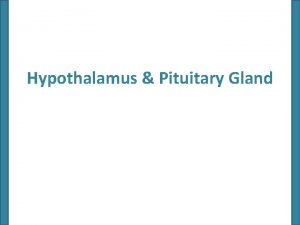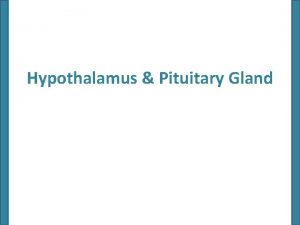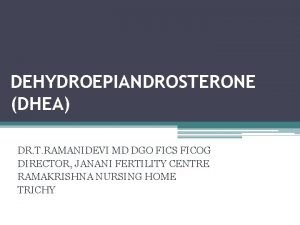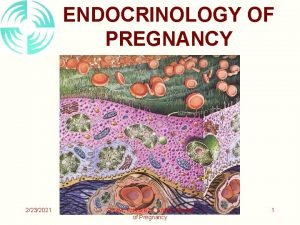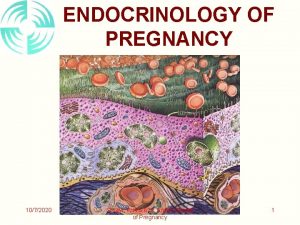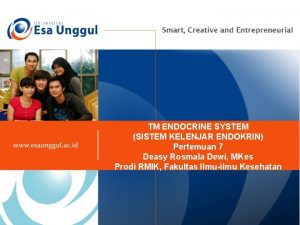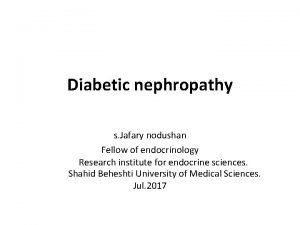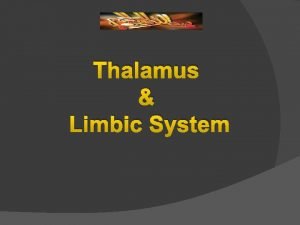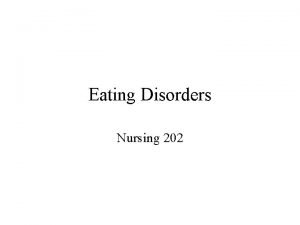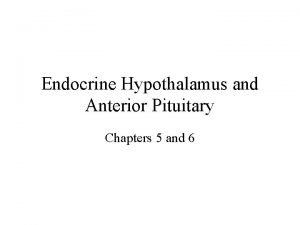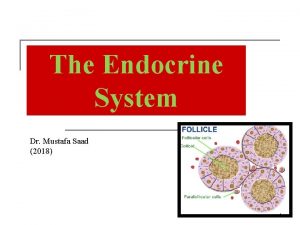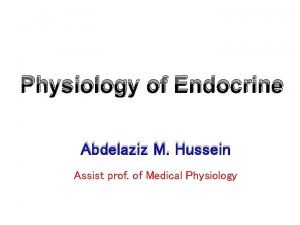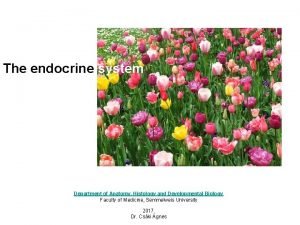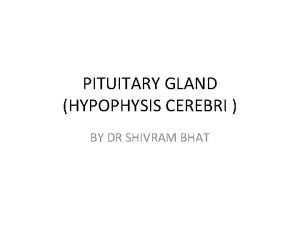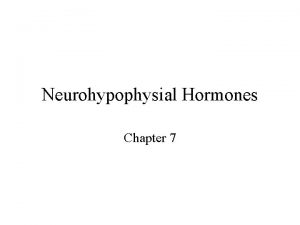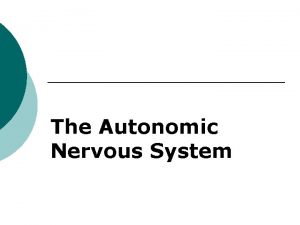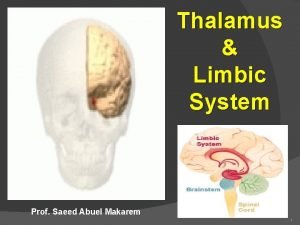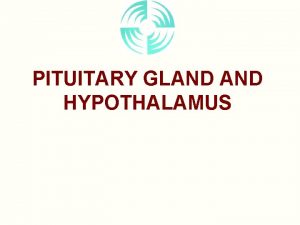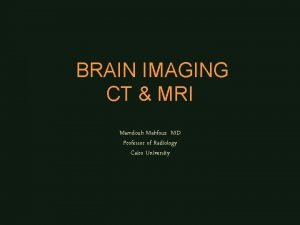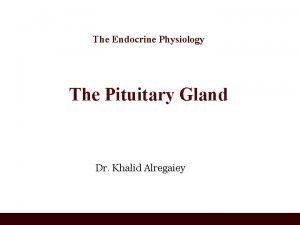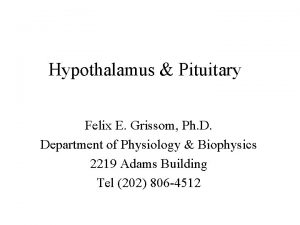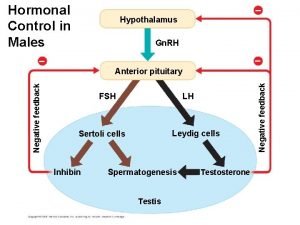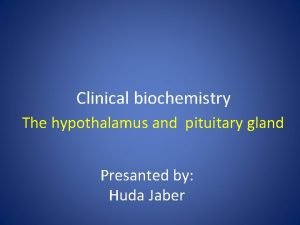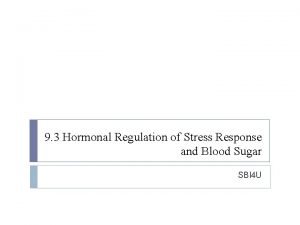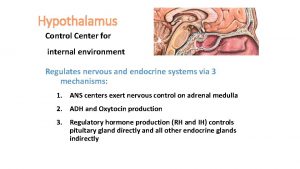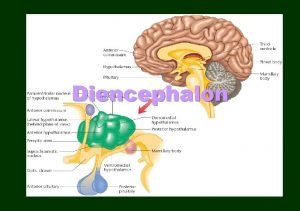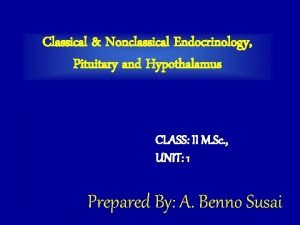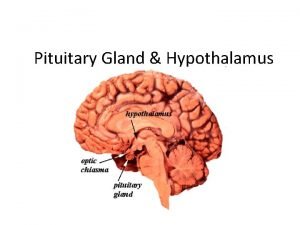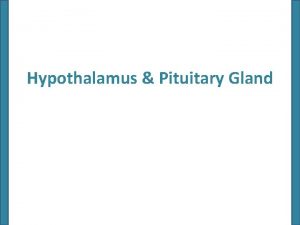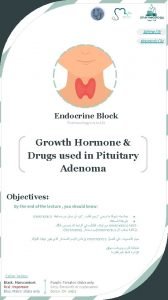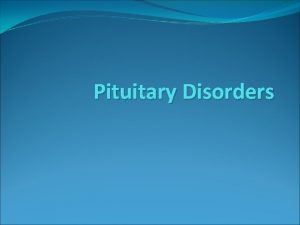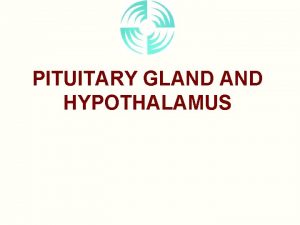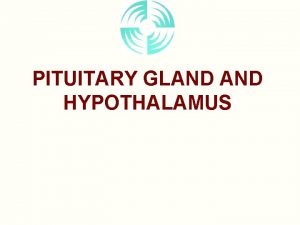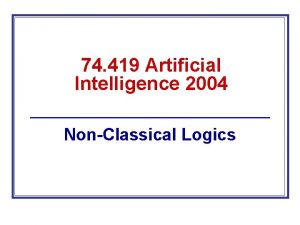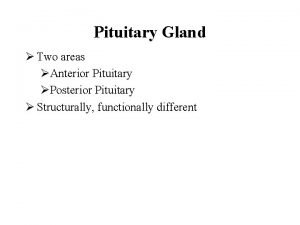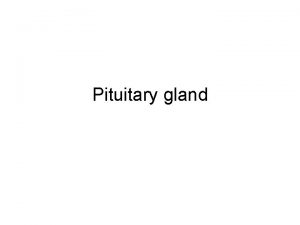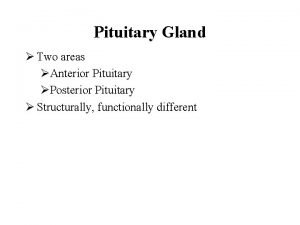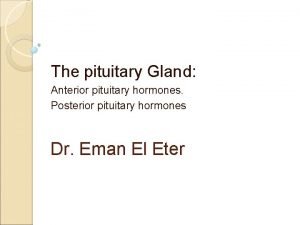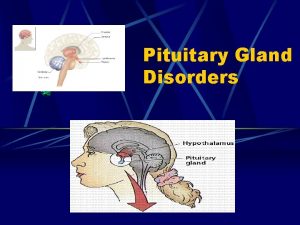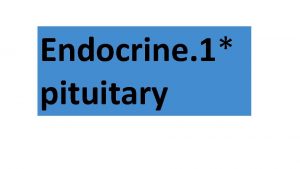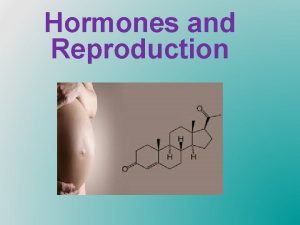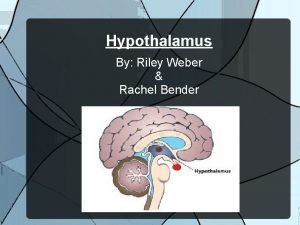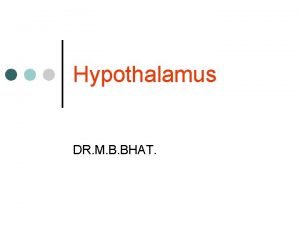Classical Nonclassical Endocrinology Pituitary and Hypothalamus CLASS II












































- Slides: 44

Classical & Nonclassical Endocrinology, Pituitary and Hypothalamus CLASS: II M. Sc. , UNIT: 1 Prepared By: A. Benno Susai

Introduction • These are synthesized at multiple sites and act locally. • By contradiction these hormones are Growth factors. • But many of these hormones exert opposite activities. • Such as growth promotion and inhibition.

Growth Factors (GF) • Most GF act in G 1 to speed the advance of an already actively dividing cell toward S stage, but have no effect on nondividing cells. These factors are known as Hormones of Progression. • Other GF can make nondividing cells sensitive to the hormone of progression, although they themselves cannot actually initiate cell division. • These factors are called Hormones of Competency

General Growth Factors Epidermal Growth Factor Family (EGF) • Consists of EGF Transforming Growth Factor α (TGF α) Epiregulin Amphiregulin Heparin Binding EGF Cripto-1

• Betacellulin • Schwannoma Derived EGF (Acetylcholine receptor inducing activity) ARIA • Neuregulins • Heregulin (Neu differentiation Factor) • Glial derived GF • Sensory and Motor neuron derived growth factor Both EGF and TGF α are membrane bound precursors (Active) that are cleaved to yield suitable hormones.

The Endocrine System

Classification of Hormones Figure 18. 2

Major Pituitary Gland Hormones

Three Methods of Hypothalamic Control over the Endocrine System

The Anatomy and Orientation of the Pituitary Gland

The anterior lobe (adenohypophysis) • Subdivided into the pars distalis, pars intermedia and pars tuberalis • At the median eminence, neurons release regulatory factors through fenestrated capillaries – Releasing hormones – Inhibiting hormones

Feedback control of Endocrine Secretion

Feedback control of Endocrine Secretion

Negative Feedback Inhibition Hormones secreted by some endocrine glands feed back to inhibit the secretion of hypothalamic releasing hormones and anterior pituitary hormones

Hormones of the adenohypophysis • Thyroid stimulating hormone (TSH) – Triggers the release of thyroid hormones – Thyrotropin releasing hormone promotes the release of TSH • Adrenocorticotropic hormone (ACTH) – Stimulates the release of glucocorticoids by the adrenal gland – Corticotrophin releasing hormone causes the secretion of ACTH

Hormones of the adenohypophysis • Follicle stimulating hormone (FSH) – Stimulates follicle development and estrogen secretion in females and sperm production in males • Leutinizing hormone (LH) – Causes ovulation and progestin production in females androgen production in males • Gonadotropin releasing hormone (GNRH) promotes the secretion of FSH and LH

Hormones of the adenohypophysis • Prolactin (PH) – Stimulates the development of mammary glands and milk production • Growth hormone (GH or somatotropin) – Stimulates cell growth and replication through release of somatomedins or IGF • Growth-hormone releasing hormone (GH-RH) • Growth-hormone inhibiting hormone (GH-IH)

Melanocyte stimulating hormone (MSH) • May be secreted by the pars intermedia during fetal development, early childhood, pregnancy or certain diseases • Stimulates melanocytes to produce melanin

The posterior lobe of the pituitary gland (neurohypophysis) • Contains axons of hypothalamic nerves • neurons of the supraoptic nucleus manufacture antidiuretic hormone (ADH) – Decreases the amount of water lost at the kidneys – Elevates blood pressure

The posterior lobe of the pituitary gland (neurohypophysis) • Neurons of the paraventricular nucleus manufacture oxytocin – Stimulates contractile cells in mammary glands – Stimulates smooth muscle cells in uterus

• Protein Anabolic • Increased plasma phosphorus • Increase absorption of calcium in gut • Diabetogenic • Growth Periods • Dwarfism • Giantism • Acromegly

• Excessive Production during childhood • Different systems respond differently

• Progression of untreated acromegly • irregular bone growth continues

• Hands • Feet • Jaws Shows the characteristics Abnormal size.

The Thyroid Gland

The Thyroid Gland

Thyroid and Parathyroid Glands • Thyroid gland – Shaped like a shield and lies just below the Adam’s apple in the front of the neck. • Thyroxine helps set basal metabolic rate by stimulating the rate of cell respiration. • In children, thyroid hormones also promote growth and stimulate maturation of the central nervous system. – unique function in amphibians - metamorphosis from larvae into adults

Thyroid follicles and thyroid hormones • Thyroid gland contains numerous follicles – Release several hormones such as thyroxine (T 4) and triiodothyronine (T 3) • Thyroid hormones end up attached to thyroid binding globulins (TBG) – Some are attached to transthyretin or albumin

The Thyroid Follicles

Formation and secretion of thyroglobulin by the thyroid cells • Thyroid cells are typical protein-secreting glandular cells • The ER and GA synthesize and secrete into the follicles a large glycoprotein called thyroglobulin (TG) (Mr Wt 335, 000) • Each TG contains about 70 tyrosine a. a • Thus TH formed within TG molecule

Oxidation of the Iodide Ion • First step is the conversion of Iodide ions o to an oxidized form of iodine either as I or I • Oxidation of iodine is promoted by the enzyme peroxidase • The enzyme is located either in apical membrane or attached to it

Iodination of Tyrosine and Formation of the Thyroid Hormones • Binding of iodine with the TG is called Organification of the TG • Enzyme Iodinase oxidises iodine within seconds • Tyrosine is first iodized to monoiodotyrosine and then to diiodotyrosine • Thus forming thyroxine that becomes the part of TG • Or one molecule of monoiodotyrosine couples with one molecule of diiodotyrosine to form triiodotyronine

The Thyroid Follicles

Thyroid hormones • Held in storage • Bound to mitochondria, thereby increasing ATP production • Bound to receptors activating genes that control energy utilization • Exert a calorigenic effect

The Parathyroid Glands

Thyroid and Parathyroid Glands • Parathyroid gland calcium homeostasis – four small glands attached to the thyroid • produces parathyroid hormone (PTH) – one of only two hormones in humans that are absolutely essential for survival – stimulates osteoclasts in bone to dissolve calcium phosphate crystals and release Ca++ into the blood

Regulation of Blood Calcium Levels

Hypothyroidism Myxedema

• Infancy onset • Persists throughout life • Severe mental retardation

• Megaglossal tongue • Druppy eyelids • Lack of genital development • Severe mental retardation

• Wasting of Temporalis and shoulder muscle • Myxedema in limbs

Graves Disease

• Fat accumulation behind eyes • High TSH • Patient previously had a thyroidectomy

REFERENCES • TEXT BOOK OF MEDICAL PHYSIOLOGY, ELEVENTH EDITION (2006), Arthur C. Guyton and John E. Hall. (Chapter -74, 75 & 76). • HUMAN PHYSIOLOGY by Wikibooks contributors. (http: //en. wikibooks. org/wiki/Human_Physi ology)
 Pituitary gland
Pituitary gland Hypothalamus and pituitary gland connection
Hypothalamus and pituitary gland connection Structure of hypothalamus and pituitary gland
Structure of hypothalamus and pituitary gland Reproductive biology and endocrinology
Reproductive biology and endocrinology Endocrinology of pregnancy
Endocrinology of pregnancy Endocrinology of pregnancy
Endocrinology of pregnancy Dr betsy schwartz
Dr betsy schwartz Hyperthyroidea
Hyperthyroidea Reproductive endocrinology near campbell
Reproductive endocrinology near campbell Endocrinology
Endocrinology Function of thalamus
Function of thalamus Hypothalamus eating disorders
Hypothalamus eating disorders Difference between anterior and posterior pituitary
Difference between anterior and posterior pituitary Hypophyseal fossa and pituitary gland
Hypophyseal fossa and pituitary gland Diaphragma sellae
Diaphragma sellae Pituitary gland and pineal gland spiritual
Pituitary gland and pineal gland spiritual Hypophyseal fossa and pituitary gland
Hypophyseal fossa and pituitary gland Dopamine agonists
Dopamine agonists Zona glomerulosa produces
Zona glomerulosa produces Parathyroid gland chief cell
Parathyroid gland chief cell Pituitary and optic chiasm
Pituitary and optic chiasm Difference between anterior and posterior pituitary
Difference between anterior and posterior pituitary Preoptic area hypothalamus
Preoptic area hypothalamus Order of visceral reflex
Order of visceral reflex Limbic system composed of
Limbic system composed of Preoptic area hypothalamus
Preoptic area hypothalamus Hypothalamus
Hypothalamus Tuber cinereum
Tuber cinereum Nontropic hormones
Nontropic hormones Psychology chapter 9 motivation and emotion
Psychology chapter 9 motivation and emotion A hormone
A hormone Amegdala
Amegdala Factors affecting growth hormone
Factors affecting growth hormone N
N Releasing inhibiting hormones
Releasing inhibiting hormones Hypothalamus
Hypothalamus Thalamus
Thalamus Presanted
Presanted Neurotransmitters in somatic nervous system
Neurotransmitters in somatic nervous system Hypothalamus epinephrine
Hypothalamus epinephrine Hypothalamus
Hypothalamus Corticoliberin
Corticoliberin 30 / 4
30 / 4 Regio subthalamicus
Regio subthalamicus Hypothalamus
Hypothalamus
